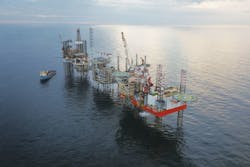Uncertain future for Danish North Sea gas
Denmark faces major disruption to its North Sea gas gathering network and uncertainty over its future as a gas producer. This follows Maersk Oil’s findings that there is no viable solution of recovering the remaining resources at Tyra, the country’s largest offshore field, as the current facilities approach the end of their operational lives. The field center, which also handles more than 90% of Denmark’s gas production, is therefore likely to be shut down from October 2018.
Safety is the main concern for Maersk and its Dansk Undergrund Consortium (DUC) partners Chevron and Shell, based on new information on storm wave impact on the platforms, combined with subsidence of the subsurface chalk reservoir which is reducing the gap between the platforms and the sea. This in spite of the fact that the DUC has spent more than $140 million over the past 15 years on structural reinforcements, in addition to extending the unmanned Tyra Southeast complex in 2015.
Maersk Oil COO Marin Ride Pedersen said the company would have to switch from rebuild planning for Tyra to engineering to discontinue Tyra as a hub for gas processing. At the same time, it will pursue options for a future redevelopment of the field.
Better news for Maersk from its HP/HT Culzean project in the UK central North Sea. Here capex is likely to come in $500 million lower than planned at around $4 billion following positive engagement with the company’s partners, suppliers, and the UK authorities. This has led to improvements in the upfront design, drilling efficiency and project planning, helped further by the recent fall in value of sterling against the dollar.
Elsewhere in this region, BP has contracted the crane vesselSaipem 7000 to remove the topsides from the drilling and production platform serving the Miller oil field, three years after the operator secured approval for the decommissioning program. Despite ceasing production in mid-2007, the facility had remained in service in minimally manned mode supporting a search-and-rescue helicopter scheme for the area operated by Bond Helicopters. The topsides are thought to weigh more than 28,730 tons.
Aker BP outlines Norway ambitions
The jackupMaersk Interceptor was due to resume development drilling at the Ivar Aasen field in the Norwegian North Sea, which came onstream on Christmas Day. Operator Aker BP, formed last year following a merger between Det norske oljeseslkap and BP’s Norwegian subsidiary, is already considering a phase two scheme that would take in the 18-MMboe Hanze satellite. Ivar Aasen produces through a conventional fixed platform, with oil and gas exported via a pipeline to Lundin’s Edvard Grieg complex for processing. Depending on reservoir performance, the facilities could operate for 20 years.
This year Aker BP plans to submit development plans for three projects: one involves expansion of the Valhall field in the North Sea (Valhall West Flank). The other two are subsea tiebacks - Snadd to the Skarv FPSO in the Norwegian Sea, and Storlakken to the North Sea Alvheim floater. In addition, the company has contracted theMaersk Invincible to drill three new wells this year from the Valhall Injection platform. Other plans include introducing gas-lift at the Tambar field and preparing the Ula facilities to handle production from the Centrica-operated Oda field development.
Ivar Aasen should help Aker BP reach its target of 128,000-135,000 boe/d this year from its Norwegian interests, and the company claims its portfolio has the potential to double output to 270,000 boe/d from 2023 onwards. It also aims to be a leading player in exploration on the Norwegian shelf, with a line-up of prospects to drill between now and 2020 that could add a net 250 MMboe.
Hurricane chasing Lancaster oil extension
Hurricane Energy is hoping to prove a northeastward extension of its fractured basement Lancaster oil field west of Shetland. Last month the semisubmersibleTransocean Spitsbergen spudded an exploration well on the Halifax prospect for Hurricane in adjoining license P2308, the aim being to prove the presence of mobile oil below local structural closure.
This, the company says, could mean that Lancaster continues northeast along the Rona Ridge. Lancaster, meanwhile, is undergoing preparations for an early production system.
Earlier, the same rig P&A’d the Lincoln discovery well in the same region for the same operator. Drilling data indicated a significant hydrocarbon column of at least 660 m (2,165 ft), Hurricane reported, suggesting the pre-drill estimate of 250 MMbbl may be conservative.
OMV, one of the partners in the original project, has completed the sale of its UK offshore interests to Siccar Point Energy. The Austrian company has also agreed to a swap transaction with Gazprom that would give the latter a 38.5% stake in OMV Norge which has interests in 32 Norwegian offshore licenses, five as operator. These include the potentially large Wisting oil discovery in the Barents Sea.
Cygnus delivers first gas
ENGIE E&P UK has brought onstream its first major greenfield project in the UK sector. The four-platform Cygnus complex 150 km (93 mi) offshore in the southern North Sea exports gas to the terminal at Bacton on the English east coast, and will eventually provide 5% of the UK’s daily gas needs from 10 horizontal wells. ENGIE and its partners are also evaluating further opportunities in the Greater Cygnus area for development when capacity becomes available. The project added £1.3 billion ($1.57 billion) to the UK economy during the five-year development, the operator added.
Independent Oil and Gas (IOG), which has amassed 500 bcf of undeveloped gas interests in the southern sector, was hoping to complete a transaction this month for a disused export pipeline connected to an onshore terminal, which has the capacity to receive up to 200 MMcf/d. IOG aims to use the pipeline to transport gas from its proposed Blythe and Vulcan Satellite projects, possibly leaving ullage for tie-ins of third-party fields.


